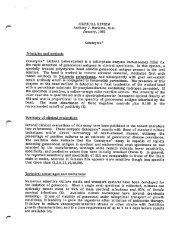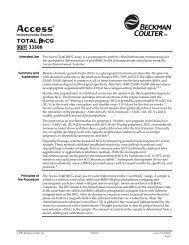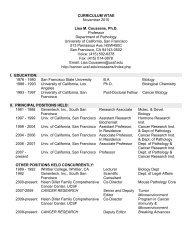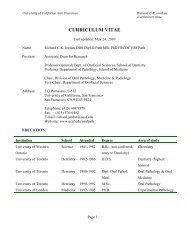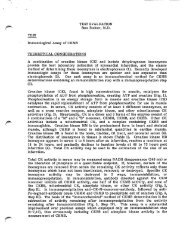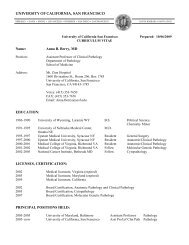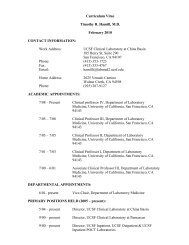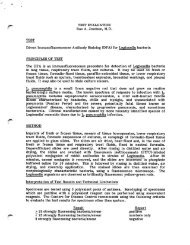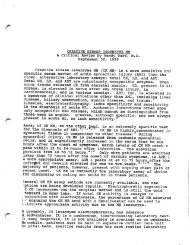Practical Guide for Frozen Sections in Surgical Neuropathology
Practical Guide for Frozen Sections in Surgical Neuropathology
Practical Guide for Frozen Sections in Surgical Neuropathology
Create successful ePaper yourself
Turn your PDF publications into a flip-book with our unique Google optimized e-Paper software.
PRACTICAL GUIDE FOR FROZEN<br />
SECTIONS IN NEUROPATHOLOGY<br />
CURRENT ISSUES IN ANATOMIC<br />
PATHOLOGY 2011<br />
Han S. Lee MD,PhD<br />
Assistant Professor, UCSF<br />
Purposes of Intraoperative<br />
Diagnosis <strong>in</strong> <strong>Neuropathology</strong><br />
A. Establish adequacy of tissue<br />
B. Prelim<strong>in</strong>ary diagnosis<br />
Help def<strong>in</strong>e surgical management<br />
Allows post-operative plann<strong>in</strong>g<br />
Outl<strong>in</strong>e<br />
Purpose/goals of <strong>in</strong>traoperative diagnosis<br />
Incorporation of cl<strong>in</strong>ical-radiologic<br />
<strong>in</strong><strong>for</strong>mation<br />
Tips on per<strong>for</strong>m<strong>in</strong>g the <strong>in</strong>traoperative<br />
frozen section/smear<br />
Interpret<strong>in</strong>g the results<br />
Key examples<br />
Purposes of Intraoperative <strong>Frozen</strong><br />
Section<br />
A. Establish adequacy of tissue<br />
Is lesional tissue present? – Can we<br />
establish a diagnosis on permanent<br />
section?<br />
Is it representative of expected pathology<br />
based on cl<strong>in</strong>ical-radiologic impression<br />
Is there enough tissue <strong>for</strong> sta<strong>in</strong>s and other<br />
studies (IPOX, etc)<br />
5/27/2011<br />
1
Purposes of Intraoperative <strong>Frozen</strong><br />
Section<br />
Is the operative procedure a biopsy only<br />
or is a resection <strong>in</strong> progress?<br />
The primary purpose of a biopsy is to<br />
obta<strong>in</strong> diagnostic tissue, hence a specific<br />
diagnosis is not necessarily required<br />
<strong>in</strong>traoperatively<br />
A diagnosis of “lesional tissue present”<br />
may suffice <strong>in</strong> such cases<br />
Cl<strong>in</strong>ical and radiologic In<strong>for</strong>mation<br />
Procedure: Biopsy only or possible<br />
resection?<br />
Age<br />
Anatomic Location of lesion<br />
Other cl<strong>in</strong>ical data:<br />
Immunodeficiency<br />
Prior treatments<br />
MRI characteristics<br />
Purposes of Intraoperative <strong>Frozen</strong><br />
Section<br />
B. Prelim<strong>in</strong>ary diagnosis<br />
Establish a pathologic category<br />
Inflammatory/<strong>in</strong>fectious vs Neoplastic<br />
Help def<strong>in</strong>e surgical management, eg:<br />
No resection Gross total resection<br />
Infection/<strong>in</strong>flammatory Circumscribed tumors<br />
Lymphoma<br />
Germ cell tumors<br />
Small cell carc<strong>in</strong>oma<br />
Allow consideration of special studies:<br />
Cultures, flow cytometry, electron microscopy<br />
Cl<strong>in</strong>ical and radiologic In<strong>for</strong>mation<br />
Procedure: Biopsy only or possible<br />
resection?<br />
Age<br />
Anatomic Location of lesion<br />
Other cl<strong>in</strong>ical data:<br />
Immunodeficiency<br />
Prior treatments<br />
MRI characteristics<br />
5/27/2011<br />
2
Cl<strong>in</strong>ical and radiologic In<strong>for</strong>mation<br />
Procedure: Biopsy only or possible<br />
resection?<br />
Age<br />
Anatomic Location of lesion<br />
Other cl<strong>in</strong>ical data:<br />
Immunodeficiency<br />
Prior treatments<br />
MRI characteristics<br />
Cl<strong>in</strong>ical and radiologic In<strong>for</strong>mation<br />
Location<br />
Intra-axial vs Extra-axial (<strong>in</strong>tramedullary vs<br />
extra-medullary)<br />
Intra- (parenchymal): gliomas, etc<br />
(neuroepithelial tumors)<br />
Extra-: men<strong>in</strong>gioma, PNST (mesenchymal<br />
tumors)<br />
Courtesy: Tarik Tihan<br />
Cl<strong>in</strong>ical and radiologic In<strong>for</strong>mation<br />
Age (and common <strong>in</strong>tra-parenchymal neoplasms)<br />
Adult<br />
Older adult<br />
Metastases, lymphoma<br />
<strong>in</strong>filtrat<strong>in</strong>g gliomas, particularly higher grade<br />
Young adult<br />
<strong>in</strong>filtrat<strong>in</strong>g gliomas<br />
circumscribed glial or glioneuronal tumors<br />
Pediatric<br />
<strong>in</strong>filtrat<strong>in</strong>g gliomas<br />
circumscribed glial or glioneuronal tumors<br />
Embryonal tumors<br />
Cl<strong>in</strong>ical and radiologic In<strong>for</strong>mation<br />
Location<br />
Intra-axial vs Extra-axial (<strong>in</strong>tramedullary vs<br />
extra-medullary)<br />
Intra- (parenchymal): gliomas, etc<br />
(neuroepithelial tumors)<br />
Extra-: men<strong>in</strong>gioma, PNST (mesenchymal<br />
tumors)<br />
Intracranial vs Sp<strong>in</strong>al<br />
5/27/2011<br />
3
Cl<strong>in</strong>ical and radiologic In<strong>for</strong>mation<br />
Location<br />
Intra-axial vs Extra-axial (<strong>in</strong>tramedullary vs<br />
extra-medullary)<br />
Intra- (parenchymal): gliomas, etc<br />
(neuroepithelial tumors)<br />
Extra-: men<strong>in</strong>gioma, PNST (mesenchymal<br />
tumors)<br />
Intracranial vs Sp<strong>in</strong>al<br />
Intraventricular<br />
Cl<strong>in</strong>ical and radiologic In<strong>for</strong>mation<br />
Immunodeficiency<br />
Lymphoma, <strong>in</strong>fections (eg Fungal, toxoplasma)<br />
Prior treatments<br />
Radiation<br />
Corticosteroids<br />
Cl<strong>in</strong>ical and radiologic In<strong>for</strong>mation<br />
Location<br />
Intra-axial vs Extra-axial (<strong>in</strong>tramedullary vs<br />
extra-medullary)<br />
Intra- (parenchymal): gliomas, etc<br />
(neuroepithelial tumors)<br />
Extra-: men<strong>in</strong>gioma, PNST (mesenchymal<br />
tumors)<br />
Intracranial vs Sp<strong>in</strong>al<br />
Intraventricular<br />
Sella turcica, p<strong>in</strong>eal<br />
Highly dist<strong>in</strong>ct differential diagnoses<br />
Radiology is essential <strong>for</strong> obta<strong>in</strong><strong>in</strong>g anatomic<br />
localization<br />
Basic radiologic (MRI) <strong>in</strong><strong>for</strong>mation<br />
Anatomic location<br />
Ill-def<strong>in</strong>ed vs discrete mass lesion<br />
Contrast enhancement on MRI:<br />
Infiltrat<strong>in</strong>g gliomas: enhancement <strong>in</strong>dicates<br />
high grade (III, IV)<br />
Circumscribed (low grade) primary tumors<br />
usually enhance<br />
Metastasis, lymphoma<br />
Inflammatory/<strong>in</strong>fectious lesions<br />
5/27/2011<br />
4
Examples of correlat<strong>in</strong>g radiology with<br />
<strong>in</strong>traoperative pathology<br />
A Contrast Enhanc<strong>in</strong>g lesion with……<br />
M<strong>in</strong>imal pathologic f<strong>in</strong>d<strong>in</strong>gs<br />
Eg gliosis, slight hypercellularity/chronic<br />
<strong>in</strong>flammation<br />
Low grade <strong>in</strong>filtrat<strong>in</strong>g glioma<br />
Necrosis only<br />
=Not representative of<br />
the lesion!<br />
Tips on per<strong>for</strong>m<strong>in</strong>g the <strong>in</strong>traoperative<br />
frozen section/smear: Tissue<br />
sampl<strong>in</strong>g<br />
1. Sample <strong>for</strong> cytologic smear<br />
2. Sample <strong>for</strong> frozen section<br />
3. Reserve tissue <strong>for</strong> unfrozen<br />
permanents.<br />
Keep <strong>in</strong> m<strong>in</strong>d that subsequent specimens may not<br />
be as representative of a lesion<br />
Basic radiologic (MRI) <strong>in</strong><strong>for</strong>mation<br />
Rim enhanc<strong>in</strong>g mass lesions may be……<br />
Glioblastoma, lymphoma, metastasis, cystic,<br />
abscess, <strong>in</strong>farct, demyel<strong>in</strong>at<strong>in</strong>g…<br />
Cytologic smears<br />
~ 1 cubic millimeter size of tissue is ideal<br />
(1 x 1 x 1 mm)<br />
5/27/2011<br />
5
10X<br />
Cytologic smears<br />
Immediate immersion <strong>in</strong> alcohol fixative upon<br />
smear<strong>in</strong>g is critical, to avoid air-dry<strong>in</strong>g<br />
<strong>Frozen</strong> Section<br />
Subtract artifactual<br />
spaces <strong>in</strong> assess<strong>in</strong>g<br />
cellularity<br />
Cellularity is often<br />
underestimated as<br />
result of artifact<br />
Permanent Section<br />
Some frozen effects/artifacts<br />
Bra<strong>in</strong> (CNS) tissue is particularly<br />
susceptible to freez<strong>in</strong>g artifact – ice crystals<br />
Water content may also reflect myxoid tissue or<br />
edema<br />
Imbed tissue <strong>in</strong> OCT (completely surround tissue<br />
with OCT, rapid freeze us<strong>in</strong>g heat s<strong>in</strong>k, avoid<strong>in</strong>g<br />
direct contact with tissue.<br />
cautery<br />
5/27/2011<br />
6
What to do if tissue received is too<br />
small<br />
Confer with surgeon<br />
Is an <strong>in</strong>traoperative diagnosis really<br />
necessary?<br />
Consider permanent section only<br />
Is more tissue com<strong>in</strong>g?<br />
(Don’t depend on it)<br />
Consider cytologic smear only, or<br />
cytologic smear be<strong>for</strong>e frozen section<br />
Interpretation: Basic pr<strong>in</strong>ciples of<br />
neuropathologic diagnosis<br />
(<strong>for</strong> parenchymal lesions)<br />
Is tissue normal or abnormal ?<br />
Abnormal: Neoplastic or non-neoplastic<br />
Neoplastic<br />
Circumscribed (discrete) vs <strong>in</strong>filtrat<strong>in</strong>g tumor<br />
Metastasis vs primary tumor vs lymphoma<br />
(high grade lesions)<br />
Non-neoplastic: Inflammatory/<strong>in</strong>fectious<br />
Infiltrative vs circumscribed neoplasms<br />
Infiltrat<strong>in</strong>g Neoplasms Circumscribed neoplasms<br />
Infiltrat<strong>in</strong>g Astrocytomas<br />
•Diffuse Astrocytoma (grade II)<br />
•Anaplastic astrocytoma (grade III)<br />
•Glioblastoma (grade IV)<br />
Oligodendroglioma Metastases<br />
Lymphoma<br />
Low grade gliomas, glioneuronal<br />
tumors:<br />
•Ependymoma<br />
•Pilocytic astrocytoma*<br />
•Ganglioglioma*<br />
•Pleomorphic Xanthoastrocytoma<br />
•And others<br />
*Certa<strong>in</strong> circumscribed tumors frequently have a degree of<br />
<strong>in</strong>filtrative growth, particularly at periphery<br />
5/27/2011<br />
7
Select example of <strong>in</strong>traoperative<br />
neuropathology<br />
Common scenario:<br />
Infiltrat<strong>in</strong>g astrocytoma vs gliosis<br />
Radiologic impression: Low grade Infiltrat<strong>in</strong>g<br />
glioma vs reactive/<strong>in</strong>flammatory<br />
Scenario 1: Infiltrat<strong>in</strong>g astrocytoma vs<br />
gliosis.<br />
38 year old man with ill-def<strong>in</strong>ed nonenhanc<strong>in</strong>g<br />
lesion and adjacent edema <strong>in</strong><br />
temporal-parietal lobe<br />
Infiltrat<strong>in</strong>g Astrocytoma<br />
Basic features of a neoplasm:<br />
Hypercellularity + cytologic atypia<br />
And an <strong>in</strong>filtrative pattern of neoplasia<br />
Individual neoplastic astrocytes <strong>in</strong>termixed with<br />
normal tissue<br />
Neuropil, neurons, swollen axons<br />
5/27/2011<br />
8
Permanent Section<br />
Infiltrat<strong>in</strong>g Astrocytoma<br />
Basic features of a neoplasm:<br />
Hypercellularity + cytologic atypia<br />
Verify hypercellularity is not due to<br />
<strong>in</strong>flammatory cells (macrophages,<br />
lymphocytes)<br />
4X<br />
<strong>Frozen</strong> section<br />
Permanent Section<br />
Macrophage-Rich Lesion<br />
20X<br />
10X 60X<br />
5/27/2011<br />
9
Infiltrat<strong>in</strong>g Astrocytoma<br />
Basic features of a neoplasm:<br />
Hypercellularity + cytologic atypia<br />
Verify hypercellularity is not due to<br />
<strong>in</strong>flammatory cells (macrophages,<br />
lymphocytes)<br />
Ensure that apparent hypercellular and<br />
homogeneous cell population is not<br />
native oligodendrocytes of white matter<br />
Ensure that “atypical cells” are not<br />
neurons, or enlarged reactive<br />
astrocytes<br />
•Reactive astrocytes may have enlarged nuclei,<br />
but show characteristic radiat<strong>in</strong>g fibrillary processes<br />
And/or gemistocytic cytoplasm<br />
• Part of heterogeneous cell population<br />
40X<br />
10X<br />
Neurons with stripped cytoplasm<br />
Smear<br />
May be well-dispersed….<br />
<strong>Frozen</strong> section<br />
Gliosis on<br />
smear<br />
40X<br />
Or clumped if severe –<br />
(mimics a hypercellular lesion)<br />
5/27/2011<br />
10
Infiltrat<strong>in</strong>g Astrocytoma<br />
Basic features :<br />
Fibrillary processes<br />
Naked atypical astrocytic (elongate) nuclei<br />
Clusters of atypical cells<br />
Uneven cell distribution<br />
Ice crystal artifact is common due to<br />
edema, myxoid<br />
+/- gemistocytes<br />
Gliosis Infiltrat<strong>in</strong>g Astrocytoma<br />
(Note clusters of<br />
atypical astrocytes)<br />
40X<br />
20X<br />
Smears of Infiltrat<strong>in</strong>g<br />
Astrocytomas<br />
May show near homogeneous<br />
population of tumor cells<br />
<strong>Frozen</strong> section:<br />
Hypercellularity?<br />
Gliosis, white matter<br />
10X<br />
Or Heterogeneous mix of cells <strong>in</strong><br />
low grade/edge of tumor<br />
Tumor various examples<br />
of cellularity <strong>in</strong><br />
<strong>in</strong>filtrat<strong>in</strong>g glioma<br />
10X<br />
5/27/2011<br />
11
20X<br />
Higher power:<br />
Increased<br />
atypical nuclei<br />
A conservative approach to<br />
<strong>in</strong>traoperative diagnosis<br />
Possible term<strong>in</strong>ologies to be used:<br />
“Scattered atypical astrocytes”<br />
“Hypercellularity”<br />
“suggest additional frozen section”<br />
“Lesional tissue present”<br />
“Infiltrat<strong>in</strong>g glioma, no high grade features”<br />
40X<br />
Infiltrat<strong>in</strong>g gray matter<br />
40X<br />
5/27/2011<br />
12





